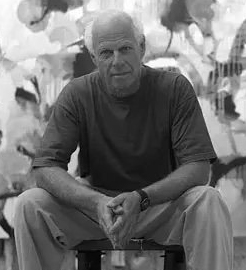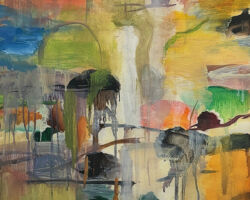 Born in New York City in 1935, Michael Mazur received a B.A. from Amherst College, Massachusetts, in 1958, studying in his senior year at the Academia di Belle Arti in Florence, Italy. He went on to earn both a B.F.A. (1959) and an M.F.A. (1961) from the Yale School of Art and Architecture, New Haven, Connecticut. Mazur’s first teaching position was at the Rhode Island School of Design from 1961 to 1964. He was awarded a Guggenheim Foundation fellowship for 1964-65. From 1965 to 1976, he taught at Brandeis University, and from 1976 to 1978 at Harvard University.
Born in New York City in 1935, Michael Mazur received a B.A. from Amherst College, Massachusetts, in 1958, studying in his senior year at the Academia di Belle Arti in Florence, Italy. He went on to earn both a B.F.A. (1959) and an M.F.A. (1961) from the Yale School of Art and Architecture, New Haven, Connecticut. Mazur’s first teaching position was at the Rhode Island School of Design from 1961 to 1964. He was awarded a Guggenheim Foundation fellowship for 1964-65. From 1965 to 1976, he taught at Brandeis University, and from 1976 to 1978 at Harvard University.
Mazur, an artist, teacher, and writer, has been active in reviving the monotype process. He contributed an essay to the pioneering exhibition catalogue The Painterly Print, published by the Metropolitan Museum of Art in 1980. Mazur chaired the New Provincetown Print Project, which encourages artists to create monotypes at the Fine Arts Work Center in Provincetown, Massachusetts. He has served on the Massachusetts Council for the Arts and Humanities. He currently resides in Cambridge, Massachusetts.
Mazur studied with Leonard Baskin, Gabor Peterdi and Bernard Chaet in the late 1950s and early 1960s, and became well known as a printmaker, depicting figurative images, household objects and anatomical forms. During the late 1960s and early 1970s, he experimented using an airbrush to apply blacks, greys and whites in multi-panel depictions of studio spaces and objects, now without figural elements, concentrating on a personal vision of pictorial space. He has worked with monotypes for many years, including a mural commissioned by the Massachusetts Institute of Technology, a pair of large triptychs in monotype with pastel, “Wakeby Day/Wakeby Night.”
Mazur has work in the collections of the Museum of Modern Art and Art Institute of Chicago.

